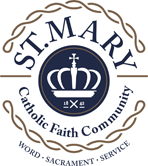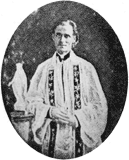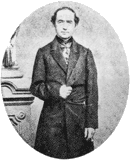| Mass Times Saturday at 4:00 p.m. Sunday at 7:30, 9:00, and 11:00 a.m. Monday-Friday at 8:15 a.m. |
 |
9520 W. Forest Home Avenue Hales Corners, Wisconsin 53130 414-425-2174 Contact Us |
St. Mary History - The 1800's
1842-1844
The first recorded mention of our parish was contained in a report to clerical friends in Ohio by Father Martin Kundig. Writing from Milwaukee on December 28, 1842, Father Kundig listed 20 parishes already established or about to be established by himself; second on the list of those in existence was St. Mary.
"St. Mary's parish, 10 miles southwest from here, has about 140 families, mostly English, that is to say, English-speaking. A church has been built."
The history of St. Mary dates from this 1842 reference, though there appears to be little doubt the parish was actually established a year or two earlier. Bishop Peter Lefevre of Detroit, who had this area of Wisconsin under his wing, and Bishop Loras of Dubuque, who made excursions even as far as Milwaukee, knew the growth potential of the church in Wisconsin. Nevertheless, it fell to Father Kundig, who initiated progress with a missionary's zeal, to help bring the matter to the attention of the church leaders in Baltimore.
 Rev. Patrick O'Kelley February - June 1842 |
The first priest in attendance at St. Mary was not Father Kundig, but Father Patrick O'Kelley, who came to Wisconsin from Ann Arbor, Michigan, in May 1839. Assigned to St. Luke in Milwaukee, his priestly duties took him on frequent trips to outlying districts where immigrant Irish, German, Scottish, English and French had long since fanned out from the city to take up farming. A well-established route was along the Janesville Plank Road, now Forest Home Avenue. Probably as early as 1840, but surely before the end of 1842, Father O'Kelley saw to the building of a log church, the first home here for St. Mary parish. This church was erected on the site of our present cemetery. Since the oldest headstone bears the name of Patrick McGowan, who died in August 1842, indications are that the site of the church, if not the actual building itself, was established prior to 1842.
Father O'Kelley's duties required serving other communities along the circuit in Oak Creek, Racine, Kenosha, Burlington and perhaps several other areas. But he had difficulty with his health, as well as his German, and he returned to Michigan in June 1842. Father Kundig, no less devoted but perhaps more physically fit, was his successor. The 140 families at St. Mary became his prime responsibility, and he is listed as our second pastor. At this period there were but five other priests in the whole territory of Wisconsin.
 Rev. Martin Kundig 1842 - 1844 |
It's unlikely that Father Kundig ever actually resided within what were then the parish boundaries, but we can glory in his personal accomplishments. Father Kundig had the wit and acumen to promote progress of church and of state side by side. Thus, he is credited with establishing the first Catholic school in Milwaukee and only a little later with influencing the move to establish a public school system in Wisconsin. His gift for organizing gains him credit in history for bringing together leaders and groups that were eventually active in formation of the state itself.
Father O'Kelley's record is not so colorful or detailed as Father Kundig's. However, there is no denying he organized Milwaukee's first Catholic Temperance Society, with which a number of St. Mary's Irish were proudly affiliated. Father Kundig in turn made news, to the East coast and beyond, with a St. Patrick's Day parade, which turned out to be a great civic and religious demonstration. His purpose was to draw attention to the importance of Wisconsin as a growing territory and to convince the Catholic hierarchy that a diocese should be created here.
The gathering of some 3,000 Catholics from about 20 southern Wisconsin parishes was so impressive that news of it put Milwaukee on the map. Church authorities realized that Wisconsin deserved a bishop who would reside in Milwaukee. On March 19, 1844, Father Henni was consecrated the first bishop of Milwaukee, although he did not arrive in the city until May. That the new bishop and Father Kundig had been lifelong friends is considered evidence of the latter's skill in human relations. By far, the majority of the first Catholics of Wisconsin were of German origin and needed religious services that English-speaking priests were unable to supply. The real beginning of satisfaction for this need was realized by the arrival of Bishop Henni, a German. St. Mary, however, was primarily an Irish parish.
1843-1892
Father William Quinn was named pastor of St. Mary in 1843, but like all early Wisconsin priests, he served a wide territory including Greenfield, Franklin, Oak Creek and Prairieville (Waukesha). Father Quinn performed the first baptisms in St. Mary's log church on November 10, 1844. Sharing this distinction were Thomas and James, twin sons of Phillip and Mary McDermott. One Thomas McLoghlan was baptized that same day. Father Quinn also performed the first marriage ceremony at St. Mary, the wedding of Nicholas Nolan and Mary Kelly on November 24, 1844.
Father Kundig, who had been in and around Kenosha since 1844, was now Vicar-General of the Milwaukee diocese. From personal knowledge of the primitive roads in this new state and the ease of travel on water, he saw the value of and promoted a canal from Muskego Lake to the Root River. Nicely situated between the east and west ends of this proposed canal in the town of Franklin was a settlement of Irish who persuaded him to name the village after his patron, St. Martin. Soon after, on April 13, 1847, Father Kundig established Holy Assumption Church there and this became the mother parish of St. Mary. Though this move affected the status of St. Mary as the mother parish of the Greenfield/Franklin area, it did not affect its identity. St. Mary was served as a mission of the Holy Assumption parish at St. Martin's until Father George Gormley built the rectory at St. Mary in 1915.
The proposed canal ran into opposition and was never built. Father Kundig left St. Martin for various assignments, the last of which was at The Cathedral of St. John the Evangelist, where he was rector for 20 years (1859-1879). Holy Assumption's present church, built in 1867, still survives. It was a mission of St. Mary until 1991.
Father Quinn remained at St. Mary until Father J. Conroy was named pastor in 1852. Three years later, Father Joseph Smith followed and built a small frame church just west of the old log church. This was the first building on the land deeded to Bishop Henni by Charles and Ellen Moore. It was completed in 1858. Father J. McGowan attended to the needs of St. Mary's parishioners in the early 1860s, and was succeeded about 1868 by Father Edward O'Connor, who had been pastor at St. Mary in Pewaukee. He died on Valentine's Day, 1873, and was buried in Franklin.
Father E. A. Graves succeeded him, but only remained for about two years, followed by the one-year tenure of Father E. McQuirk. The next pastor was Father John J. Kinsella. He completed St. Matthew's church in South Milwaukee while a professor at St. Francis Seminary, and died in Franklin March 4, 1879.
Father Fagan was pastor from 1876 - 1878, and Father Tierney followed him from 1878 - 1881. Between 1881 and 1892, Fathers O'Neil and Horan were the pastors.
1893-1915
Father J.W. O'Keefe was in charge when the "cream city" brick church was built in 1893. A landmark along Forest Home Avenue, it served the parish for the next 60 years. The frame church it replaced was eventually moved to land on what is now South 108th Street, just south of West Layton Avenue, and survived until demolished in a highway widening project in 1966. Father O'Keefe was born near Madison and ordained in 1891. St. Mary was his second assignment. Followed him as pastors from 1895 to 1915 were Fathers J.T. O'Leary, Phelim Hughes, E.A. Hemming and Gormley.